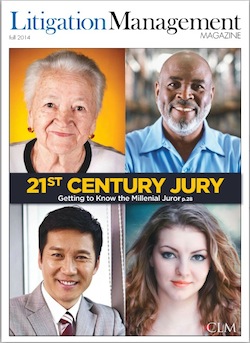| Forward | Subscribe |
 |
April 2015 |
|
| Get A Quote | Ringler Home | Find Advisor | Everybody Wins |
Incorporate Generational Differences Into Your Trial Strategy
 Millennial jurors demonstrate an inherent distrust of institutions.
Millennial jurors demonstrate an inherent distrust of institutions.The dynamics of today’s juries are shifting. This year, baby boomers will be replaced statistically by millennials as the new generational king of the hill. That means millennials (aka Generation Next or Gen Y), along with Gen Xers, will have a growing influence in the jury box.
Each generation has a distinct personality that was shaped by the world in which it grew up. And while the characteristics assigned to a particular population are generalizations by nature, the thoughtful barrister should consider these shared experiences and values when preparing a case. Here’s a closer look at each generation:
-
The Traditionalists 1922-1945: Those born prior to World War II and whose earliest memories are associated with that cataclysmic event. Weaned on the Great Depression, this group values the work ethic and traditional family values. They respect authority and hierarchy and are good team players. Heroes: FDR, Eisenhower, Audie Murphy. Cultural icons: Mickey Mouse, Superman, The Lone Ranger.
-
The Baby Boomers 1946-1964: Grew up during an intense period of conflict and social change, including the Kennedy assassination, the Vietnam War and the civil rights movement. This group is confident, independent and tends to question authority. Goal-oriented, boomers may criticize X and Y generations for a lax work ethic. Heroes: Martin Luther King Jr., the Kennedys, John Glenn. Cultural icons: “The Ed Sullivan Show,” TV dinners, the peace sign.
-
Generation X 1965-1980: Major life experiences include Watergate, the HIV/AIDS crisis, the fall of the Berlin Wall and Operation Desert Storm. The first generation to grow up with computers, the Xers are ethnically diverse and generally more educated than the boomers. They embrace a hands-off management philosophy and are also said to work to live rather than live to work. Heroes: none! Cultural icons: Pet rocks, platform shoes, “The Simpsons.”
- Generation Y/Millennials 1981-1997: Survived school shootings, celebrity scandals (Clinton/Lewinsky, Woods, Schwarzenegger) and the horrors of 9/11. They were raised with smartphones, iPods and iPads in their hands, and prefer to communicate via social media rather than by telephone or face-to-face. Extremely team-oriented, millennials have high expectations from their employers. Heroes: Michael Jordan, Bill Gates, Mia Hamm. Cultural icons: Barney, Teenage Mutant Ninja Turtles, Beanie Babies.
The Rise of the Millennials
Again, every juror is unique, and not all millennials share the same beliefs. However, jury experience and research show that certain attitudes are prevalent enough to warrant serious consideration when preparing for trial. These include:
Information technology
Millennials have had instant access to information since early childhood and are unlikely to accept that information is not immediately accessible. You can bet that they will Google, Facebook and Twitter search anything and everything about your client. Their need for instant gratification also leads to a shorter attention span, so key facts need to be repeated throughout the trial.
Distrust of institutions
Thanks to Enron, the banking crisis, the Iraq War, the BP oil spill and other seminal experiences, millennials have strong anticorporate beliefs. It also doesn’t help that many millennials are graduating from college with serious debt and limited job opportunities. In addition, events like 9/11 and Columbine make them believe that everyone should have a security plan in place to prevent similar events from happening to them or someone close to them.
Higher damage awards
Data from several mock trials and jury research exercises have shown that millennials are significantly more likely to award higher damages in almost any type of case. The research showed:
- Non-millennials awarded a median damage award of $3.5 million, while millennials almost doubled down, at $6 million.
- Minority millennials went even further, awarding a median damage award of $9.7 million.
Final Word
Never before has such a diversity of generational backgrounds existed in one jury pool: traditionalists, boomers, Xers and millennials. This diverse population of jurors means you would be well advised to incorporate generational demographics into your trial strategy. While predicting a verdict is impossible, understanding the generational differences at work with jurors is clearly better than having no hand to play at all.
For more information, check out 21st Century Jury: Getting to Know the Millennial Juror from Litigation Management. Also consider picking up Generations at Work by Ron Zemke, Claire Raines and Bob Filipczak.






